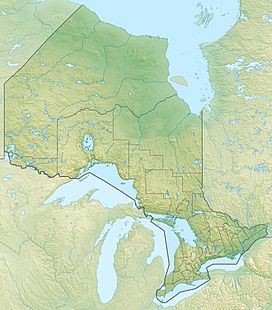Agawa Canyon facts for kids
Quick facts for kids Agawa Canyon |
|
|---|---|

The Agawa Canyon Wilderness Park
|
|
| Floor elevation | 316 m (1,037 ft) |
| Long-axis direction | North-south |
| Depth | 175.2 metres (575 ft) |
| Geology | |
| Type | Geologic fault expanded by erosion |
| Geography | |
| Location | Algoma District, Ontario, Canada |
| Topo map | NTS 041N08 |
| Traversed by | Algoma Central Railway |
| Rivers | Agawa River |
The Agawa Canyon is a beautiful, shallow canyon found deep in a quiet part of Ontario, Canada. It was formed about 1.2 billion years ago. This happened when the Earth's crust cracked along the Canadian Shield. Over time, the Agawa River helped to make the canyon wider and deeper by slowly wearing away the rock.
The Agawa Canyon Wilderness Park is a special place. You can only reach it by hiking or by taking the Algoma Central Railway. It's about 114 miles (183 km) by train northwest of Sault Ste. Marie.
Contents
What is the Agawa Canyon Like?
Geography of the Canyon
The canyon walls are very tall. At their highest point, they rise about 175 meters (575 feet) above the Agawa River. The park is located where two different types of forests meet. These are the Great Lakes – St. Lawrence Forest and the Boreal Forest. This means you can find many different kinds of plants from both areas here.
The Agawa Canyon gets a lot of snow each year. It usually gets more than 450 centimeters (177 inches) of snow. In the winter of 1989, there was a record snowfall of 782 centimeters (308 inches)!
Waterfalls in the Canyon
Four amazing waterfalls can be found along the edges of the canyon. They all feed into the Agawa River.
- The North and South Black Beaver Falls are both about 53 meters (175 feet) high.
- The tallest waterfall in the park is Bridal Veil Falls, which is about 68 meters (225 feet) high.
- Otter Creek Falls is the shortest, at about 13 meters (45 feet) high.
The upper part of Otter Creek is a natural place for speckled trout to lay their eggs. Small beaver ponds above the canyon feed the Otter Creek Falls.
Plants and Animals of Agawa Canyon
Plants You Might See
Many colorful plants bloom in the spring and summer.
- In spring and summer, you might see fireweed, yellow and orange hawkweed, Oxeye daisy, nodding trillium, and yellow clintonia.
- Later in the season, you could spot viper's bugloss, bladder campion, yarrow, evening primrose, and different kinds of asters.
Animals You Might See
The Agawa River is home to many Beaver and otter. Several types of ducks also live here, including mergansers, wood ducks, and goldeneyes.
While large animals like moose and bear don't visit often, you can find many small mammals. These include chipmunks, meadow voles, and groundhogs.
Many birds are commonly seen in the canyon:
Birds of prey, also known as raptors, also fly over the canyon. These include merlins, golden eagles, broad-winged hawks, and American kestrels.
History of Agawa Canyon
The Railway and Tourism
The first railway tracks were laid in the Agawa Canyon in the winter of 1911. The Algoma Central Railway started to develop the Agawa Canyon Wilderness Park in 1952. They began by clearing a picnic area for visitors.
Thanks to the Algoma Central's Agawa Canyon Tour Train, the area has become a popular tourist spot. Since 1952, more than three million people have visited Agawa Canyon! The word "Agawa" comes from the native Ojibway language and means "shelter."
Artists and the Canyon
Between 1918 and 1923, several famous Canadian artists visited the Algoma region to paint. These artists were part of a group called the Group of Seven. Some of them included Lawren Harris, A. Y. Jackson, Frank Johnston, J. E. H. MacDonald, and Arthur Lismer.
To get to these wild areas, they rented a special boxcar from The Algoma Central Railway. This boxcar was set up like a small cabin. The railway would move it to different spots near great painting locations. From there, the artists would explore on foot or by canoe to capture the beautiful, wild scenery on their canvases.
Fun Things to Do in Agawa Canyon
Hiking Trails
There are five short nature trails in the park for visitors to explore:
- The Ed Foote Trail
- Lookout Trail
- Otter Creek Trail
- River Trail
- Talus Trail
The Lookout
Visitors can climb 372 steps to reach the "Lookout." This observation platform is located on the canyon wall, about 76 meters (250 feet) above the railway tracks. From here, you get an amazing panoramic view of the entire canyon!
Train Tours
The Algoma Central Railway offers special tour trains to the canyon.
- In the summer and fall, you can take a tour to see the beautiful changing colors of the leaves.
- In December, January, and February, they offer a "snow train" for a winter wonderland experience.
Ice Climbing
For adventurous visitors, ice climbing is another exciting activity. Some popular ice climbing routes in this area are called Trestle, Salmon Run, and Sweating Whiskey. The train drops off climbers between mile 110 and 114. Campers often set up tents or temporary shelters near the tracks.


